A Christmas Carol is Charles Dickens's best known and best loved work; and the story of the miserly curmudgeon Ebenezer Scrooge's dark journey of the soul, in the company of the ghosts of Christmas Past, Present and Yet to Come, is as fresh and as popular today as it was when it first appeared in 1843.
The book is, without doubt, a masterpiece - and yet, given the timelessness of its brilliantly woven plot, it is amazing to think that it took Dickens just six weeks to write it; starting work on what he called his "little scheme", in mid-October, 1843, and finishing it on 2nd December, 1843.
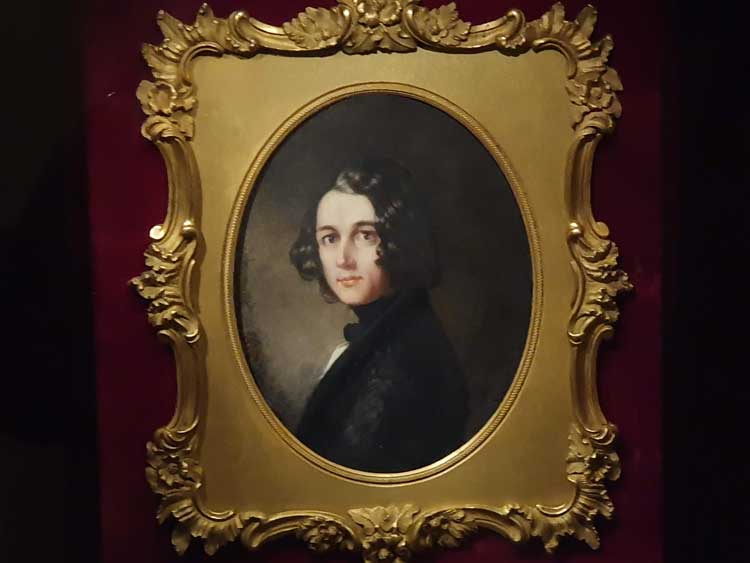
Dickens In 1843 - The Year He Wrote A Christmas Carol
Courtesy of the Charles Dickens Museum
During those six weeks, Dickens was all-consumed by the writing of the novella, and he threw himself wholeheartedly into its composition, later recalling to his American friend Cornelius Conway Felton, professor of Greek at Harvard, that:-
"Charles Dickens wept and laughed and wept again, and excited himself in a most extraordinary manner in the composition, and thinking whereof, he walked about the black streets of London, fifteen and twenty miles, many a night when all the sober folks had gone to bed."
In consequence of Dickens's compositional nocturnal perambulations, London permeates the pages of the Carol. The City looms menacingly over Stave One, and its brooding presence makes it as much a character in the work as it is the backcloth against which the story of Scrooge's redemption and transformation takes place.
And, of course, it's there in Stave Five, when the redeemed Scrooge awakes on Christmas morning to hear the City's churches "ringing out the lustiest peals he had ever heard," and he looks out of his window to find that the ominous fog and mist of the previous evening have been replaced by "Clear, bright, jovial, stirring cold..." in keeping with Scrooge's likewise changed inner temperament.
But, is it possible for the modern day reader to visit the locations that Dickens featured in the narrative of the novella, and, if so, where are they?
Well, to borrow shamelessly from Dickens himself, I have endeavoured on this ghostly little page to track down the locations that feature in A Christmas Carol in order that my readers may visit each one of them; and, when they do so, may they haunt their hours pleasantly!
So, without further ado, let us begin our journey - oh, and before we set off, permit me to repeat, emphatically, that Marley was dead, to begin with.
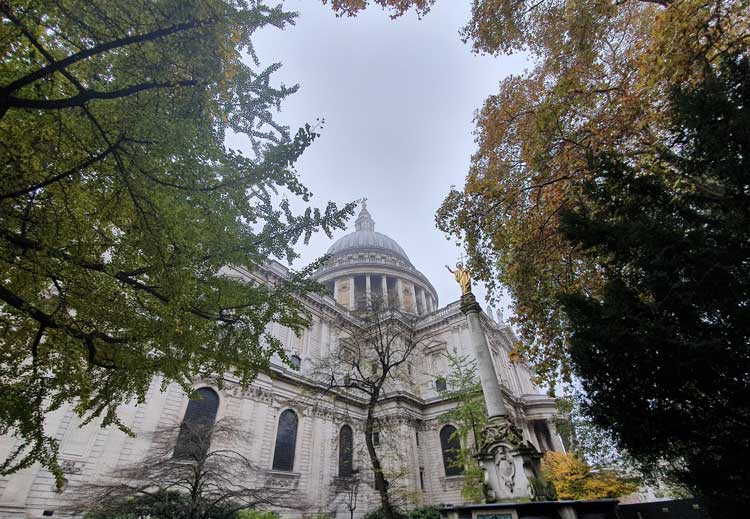
In Stave One, as Dickens strives to remind us over and over again of the importance of remembering that "Marley was dead,", he mentions St. Paul's Churchyard.
Having told us that, "There is no doubt that Marley was dead. This must be distinctly understood, or nothing wonderful can come of the story I am going to relate," he goes on to observe that:-
"If we were not perfectly convinced that Hamlet's Father died before the play began, there would be nothing more remarkable in his taking a stroll at night in an easterly wind, upon his own ramparts, than there would be in any other middle-aged gentleman rashly turning out after dark in a breezy spot - say Saint Paul's Churchyard for instance - literally to astonish his son's weak mind."

Although Dickens is, in fact, non specific about the exact location of the counting house in which we first encounter Scrooge, the curmudgeonly protagonist of the novella, a likely contender is the tiny, and easily missed, Newman's Court, a dingy and not particularly inviting passage off Cornhill.
The only clue that he gives us in the narrative is to tell us that the counting house was beneath an ancient church tower, "...whose gruff old bell was always peeping slily down at Scrooge out of a gothic window in the wall..."
The mention of the "gothic window" in the wall limits our choices, since only a handful of church towers possessed this architectural feature when Dickens was writing A Christmas Carol. St. Dunstan's in the West had one; St. Mary Aldermary had one; and so to did St. Michael on Cornhill.
The fact that Bob Cratchit, on leaving the counting house, "...went down a slide on Cornhill..." suggests to me that its was St Michael, Cornhill, that Dickens had in mind; and, since Newman's Court is almost directly opposite the church, then I am inclined to favour it as the location for Scrooge's counting house; albeit, I readily acknowledge that this has to be speculation, but then, that's half the fun of this little game!
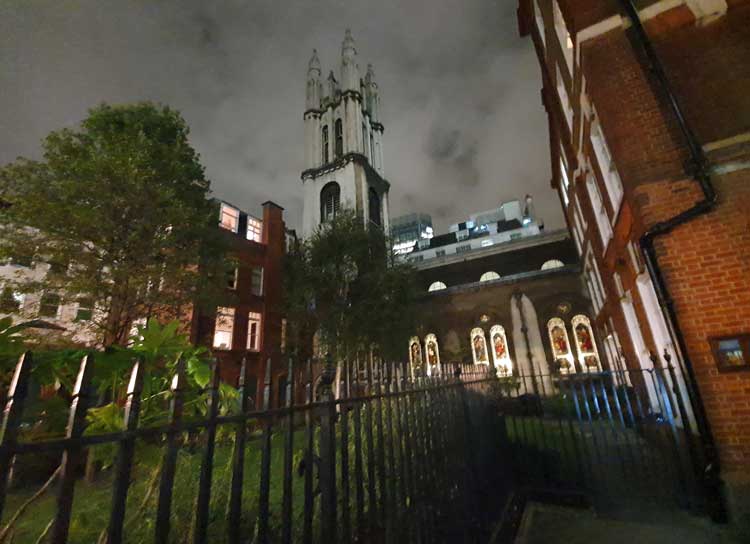
As with Scrooge's counting house, so it is with "The ancient tower of a church."
The only visual prompt that we get from Dickens is the fact that the "gruff old bell was always peeping slily down on Scrooge out of a gothic window in the wall..."
But that is sufficient for us to, if not to identify the actual church tower that Dickens had in mind, at least limit the number of contenders.
The only thing that can be stated with any degree of absolute certainty is that it must have been in the City of London. That, after all, is where Scrooge does business. And, with Bob Cratchit's choosing of Cornhill as the thoroughfare on which to go "...down a slide...at the end of a line of boys, twenty times, in honour of its being Christmas Eve...", it must have been a church in the vicinity of Cornhill that Dickens had in mind.
St. Michael's, Cornhill does, therefore, fit the bill, and thus am I inclined to the belief that this was the tower which, "became invisible and struck the hours and the quarters in the clouds, with tremulous vibrations afterwards as if its teeth were chattering in its frozen head up there..."
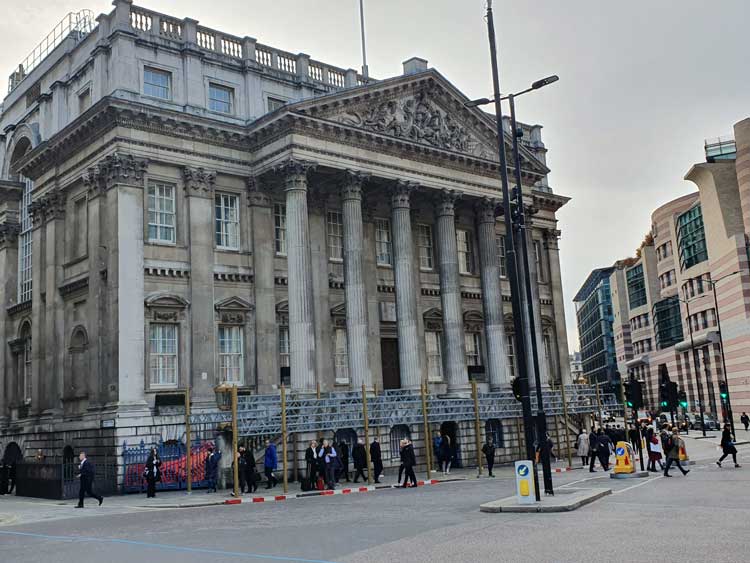
One London location that Dickens is specific about in the opening Stave of A Christmas Carol is the Mansion House, home to the Lord Mayor of London during his (and now occasionally her) one year in office.
As the Christmas Eve cold becomes intense, Dickens contrasts Scrooge's attitude to Christmas with the attitudes of his fellow citizens, the large majority of whom are excitedly preparing for the coming festivities. Honing in on the Mansion House, he tells us that:-
"The Lord Mayor, in the stronghold of the mighty Mansion House, gave orders to his fifty cooks and butlers to keep Christmas as a Lord Mayor's Household should..."
Interestingly, this passage has changed from the version that Dickens originally wrote; for, in the manuscript version of the Carol, the passage actually reads:-
"The Lord Mayor in the stronghold of the awful Mansion House gave orders to his fifty cooks and butlers to keep Christmas as a Lord Mayor's household should..."
I can only surmise that "awful" was changed to "mighty" for fear of causing offence to the then incumbent of the office and to subsequent Lord Mayors!
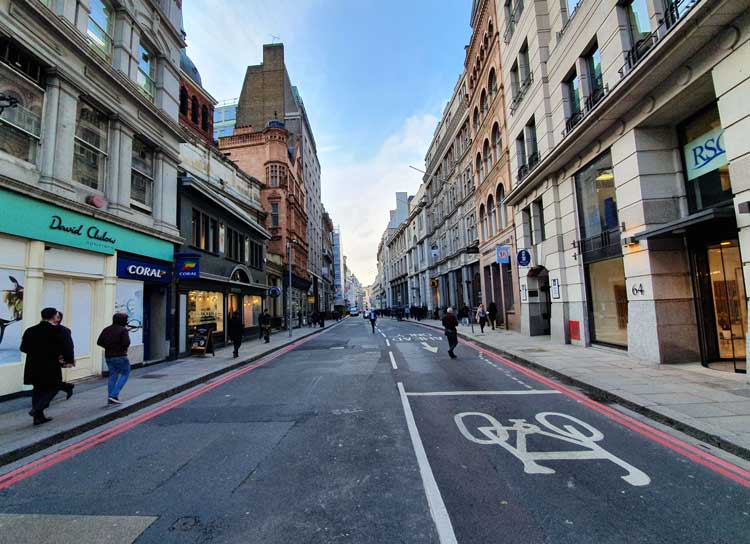
We are, quite literally, on safer ground with this location, since it is one of the few locations to actually get a name check in the narrative of A Christmas Carol.
As, at length, the hour of shutting up the counting house arrived, Scrooge's clerk - who, incidentally hasn't yet been named as Bob Cratchit and is referred to simply as "the clerk" - is told that he can finish for the day.
On hearing the cheering news, the clerk, "instantly snuffed his candle, and put on his hat."
Scrooge, however, is not the sort of employer to wish him the compliments of the season and express the hope that he'll enjoy a merry Christmas with his family - indeed, at this point, Scrooge knows next to nothing of his clerk's domestic arrangements. His only nod to the fact that the next day is Christmas Day is to gruffly enquire of his clerk, "You'll want all day tomorrow, I suppose?"
"If quite convenient, Sir," replies the clerk.
Old curmudgeon that he is, Scrooge grudgingly informs his clerk that it's neither convenient nor fair, and when the clerk tries to argue that it's only once a year, fires back with the observation that such an argument is, "A poor excuse for picking a man's pocket every twenty fifth of December."
The clerk promises that he will be in all the earlier the next morning, and then sets off to walk home.
But, with his mood lifting at the prospect of Christmas Day with his family:-
"...the clerk with the long ends of his white comforter dangling below his waist (for he boasted no great coat) went down a slide on Cornhill, at the end of a lane of boys, twenty times in honour of its being Christmas Eve, and then ran home to Camden Town as hard as he could pelt, to play at blindman's buff."

With Bob Cratchit having headed home to Camden Town, Scrooge himself sets off to make his way home, stopping en route to take "..his melancholy dinner in his usual melancholy tavern", where he read all the newspapers, "and beguiled the rest of the evening with his banker's-book."
But, guess what? Dickens doesn't name Scrooge's usual melancholy tavern, leaving us to speculate which City hostelry he could have had in mind.
So, let's play a game of guess the melancholy tavern.
Let's begin by presuming that the tavern would have been in the City of London, and probably in the vicinity of Cornhill.
As it happens, there are a number of taverns tucked away in the alleyways that snake their way off and behind Cornhill; and, in Dickens's day, there were a few more.
A possible contender for the one at which Scrooge stopped off at was Garraway's, which used to stand in Change Alley.
Another contender is Simpsons, situated in the extremely melancholic Ball Court. This City institution has been expanding the girths of bankers and financiers since 1757, so it would most certainly have been around when Scrooge was making his way home on that long ago Christmas Eve.
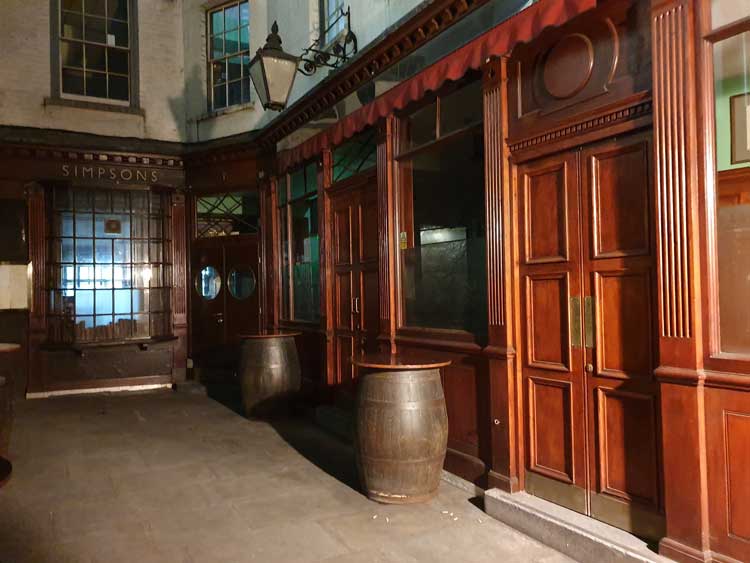
However, of all the potential taverns, I personally am inclined to plumb for the George and Vulture in St Michael's Alley.
Dickens knew this venerable old hostelry well, and he had featured it in Pickwick Papers as the place where Mr. Pickwick took up his abode, "in very good, old-fashioned and comfortable quarters, to wit, the George and Vulture Tavern and Hotel, George Yard, Lombard Street..."
To this day the George and Vulture is indelibly linked with the memory of Charles Dickens. A white marble bust of him keeps a watchful eye on diners from a downstairs, timeworn window ledge; and, just before Christmas each year, Dickens descendants assemble in the tavern's upper room and enjoy the Dickens family Christmas luncheon.
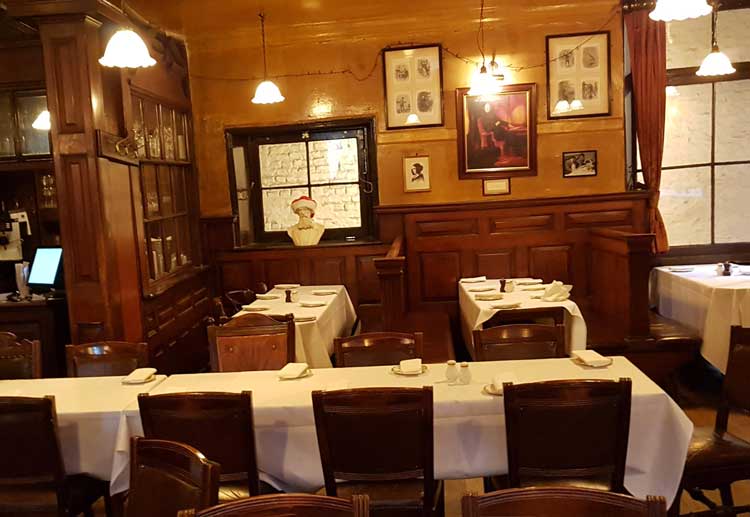
So, despite some stiff competition, I personally would say that of all the melancholy taverns that surround Cornhill, the George and Vulture is the one in which Scrooge whiled away Christmas Eve reading all the newspapers "and beguiled the rest of the evening with his banker's-book."
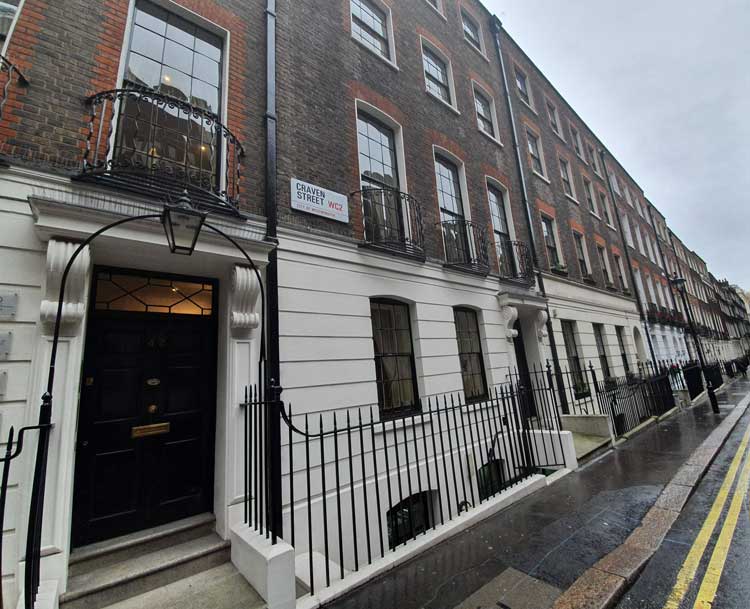
When Scrooge arrived home, the yard was so dark, "that even Scrooge who knew its every stone, was fain to grope with his hands."
Groping his way through the darkness, he arrived at his door, at which point we are treated to one of the most memorable images in the novella.
"Now, it is a fact, that there was nothing at all particular about the knocker on the door, except that it was very large. It is also a fact, that Scrooge had seen it, night and morning, during his whole residence in that place...then let any man explain to me. if he can, how it happened that Scrooge, having his key in the lock of the door, saw in the knocker, without its undergoing any intermediate process of change - not a knocker, but Marley's face..."
Legend holds that this scene was inspired by a particularly grotesque old doorknocker that Dickens encountered one afternoon on a door of one of the houses as he was walking along Craven Street, off Strand.
Unfortunately, when the owner of the house was approached by an over-enthusiastic photographer who sought permission to photograph the knocker, she decided to have it transferred to a bank vault for safe keeping, and the whereabouts of it have long since been lost.

The game is once more afoot, as we follow Scrooge through his front door and into his "gloomy suite of rooms, in a lowering pile of building..."
There is evidence in the text to suggest that Dickens must have had a particular building in mind for the abode of Ebenezer Scrooge; but, as to the exact address at which the miserly skinflint underwent his overnight transformation, we are destined to remain as much in the dark as Scrooge himself was when he arrived home on Christmas Eve.
Dickens writes as follows of Scrooge's living arrangements:-
"He lived in chambers which had once belonged to his deceased partner. They were a gloomy suite of rooms in a lowering pile of building up a yard, where it had so little business to be, that one could scarcely help fancying it must have run there when it was a young house, playing at hide-and-seek with other houses, and forgotten the way out again."
He also mentions that, when Scrooge is forced to grope his way through the darkness of the yard, prior to his encounter with the spectral vision on the doorknocker, that:- "The fog and frost so hung about the black old gateway of the house, that it seemed as though the Genius of the Weather sat in mournful meditation on the threshold."
So, we know that the house was tucked away down a yard, that it had a black old gateway, and that it was a lowering pile - that is, it had a dark and threatening ambience.
There are several courts in the City of London that have houses tucked away within them where they have so little business to be.
White Lion Court, at the eastern end of Cornhill has an 18th century mansion secreted away within it; and Wardrobe Place and Groveland Court, both near St. Paul's Cathedral, are also home to hidden abodes.
My own favoured "lowering pile", however, is number 4 Brabant Court, off Philpot Lane - which dates from the 1720s, and which most certainly looks as though it may well have run in there when it was a very young house and forgotten the way out.
There's even a black old gate alongside the house.
All in all, it is the ideal location for a plethora of phantoms to wander hither and thither in restless haste, and moaning as they went.
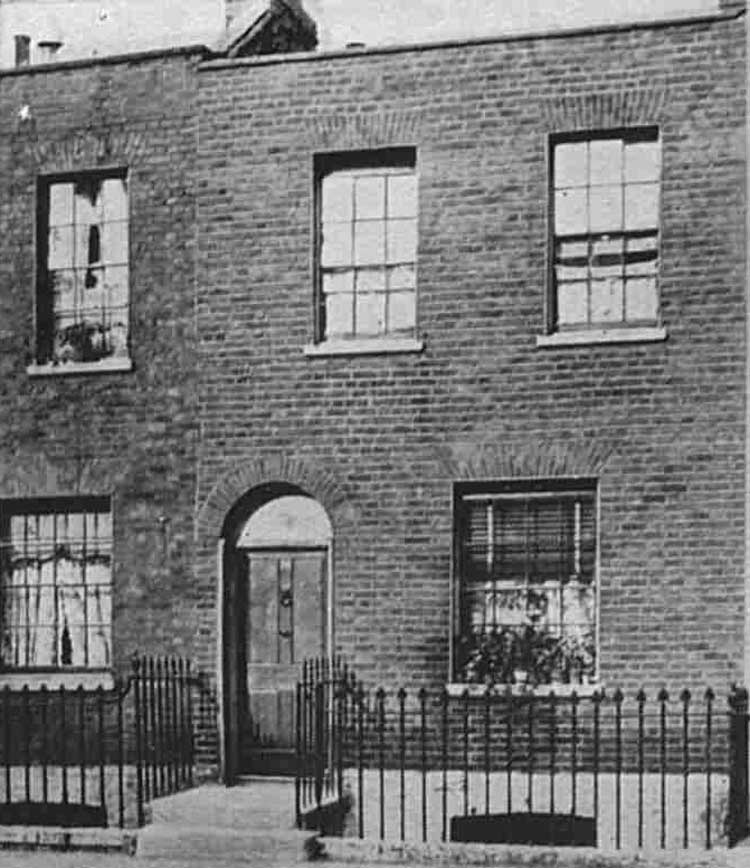
Having gone down the slide on Cornhill, Scrooge's clerk then, "...ran home to Camden Town as hard as he could pelt, to play at blindman's buff."
So we know that, when the Ghost of Christmas Present takes Scrooge to Bob Cratchit's house, it was located in Camden Town.
A likely contender for the clerk's humble abode is 16 Bayham Street, as this was the address to which the Dickens family came on their return to London from Kent when Charles was a little over nine years old.
Writing of the family's time here, and of the effect it had on Charles's imagination and later creative process, in his The Life Of Charles Dickens, John Forster tells us that:-
"Bayham-street was about the poorest part of the London suburbs then, and the house was was a mean small tenement, with a wretched little back-garden abutting on a squalid court...That he took, from the very beginning of the Bayham-street life, his first impression of that struggling poverty which is nowhere more vividly shown than in the commoner streets of the ordinary London suburb, and which enriched his earliest writings with a freshness of original humour and quite unstudied pathos..."
The Cratchits house might have been a "mean small tenement" but the Ghost of Christmas Present had no hesitation in pausing on the threshold of the door to bless Bob Cratchit's dwelling with the sprinkling of his torch:-
"Think of that! Bob had fifteen 'Bob' a-week himself; he pocketed on Saturdays but fifteen copies of his Christian name; and yet the Ghost of Christmas Present blessed his four-roomed house."
Sadly, we can no longer stand outside that mean small tenement and picture the Cratchit family happily enjoying their Christmas meal within its walls, since it has long-since been demolished, albeit several properties have survived in the street to at least give us an impression of what it would have looked like.
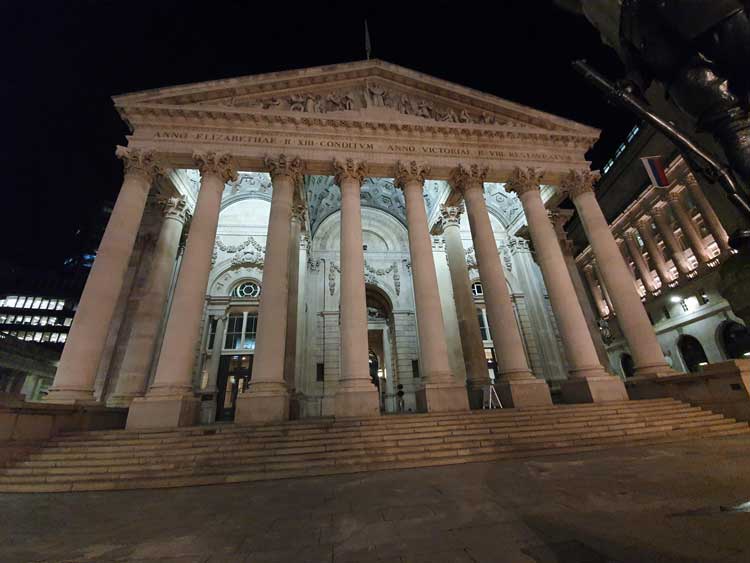
Having been taken through his past and present, Scrooge then endures the most terrifying of the three spirits - the Ghost of Christmas Yet To Come - the silent shape that he "feared so much that his legs trembled beneath him."
However, since the Ghost of the Future's purpose is to do him good, he willingly follows as the ghost leads him on into the fast waning night.
Having resolved to change his miserly ways, Scrooge is convinced that the spirit is going to show him as "another man", kinder and more considerate, in the years that lie ahead, he is somewhat puzzled when the first place the Spirit takes him to is:-
"'Change, amongst the merchants, who hurried up and down, and chinked the money in their pockets, and conversed in groups, and looked at their watches, and trifled thoughtfully with their great gold seals, and so forth, as Scrooge had seen them often."
Dickens may well have had in mind the Royal Exchange for this particular scene, located between Cornhill and Threadneedle Street; albeit, it most certainly would not have been the building we are looking at today.
The previous Royal Exchange had burnt down in a fire in 1838, and this building was a year from completion and opening when Dickens wrote A Christmas Carol in 1843.
Once inside, the Spirit stops alongside a group of businessmen who are discussing somebody who has died the previous night.
They do not seem particularly cut up about the man's death. Indeed they only have two concerns.
One gentleman, wants to know what the deceased man has done with his money? "God Knows," replies another with a yawn, "Left it to his company perhaps.. He hasn't left it to me."
"It's likely to be a very cheap funeral", comments the same speaker, "for upon my life I don't know of anybody to go to it."
The men then discuss whether they should make up a party and volunteer to attend. "I don't mind going if a lunch is provided", states one of their number. "But I must be fed..."
In other words, the only concern these men have about the recently deceased man is, what has become of his money? and will they get fed if they "volunteer" to attend his funeral.
Scrooge hasn't yet twigged who it is that they are talking about. Indeed, later in the scene, he even, "looked about that very place for his own image, but another man stood in his accustomed corner, and though the clock pointed to his usual time of day for being there, he saw no likeness of himself among the multitudes that poured in through the Porch..."

Scrooge's journey towards redemption edges ever closer as the Ghost of Christmas Yet To Come leads him through the streets of London, where most people seem not be be in the least bit affected by the death of the man who was being discussed at the Royal Exchange.
They find their way to an obscure part of town, where the whole quarter reeks with crime, filth and misery. Here they watch as a group of sinister characters sell the man's possessions to a rag and bone man, observing as they do that the dead man "frightened every one away from him when he was alive, to profit us when he was dead! Ha, ha, ha!"
But still Scrooge hasn't figured out - or won't admit - who the dead man is. He simply observes to the spirit that, "The case of this unhappy man might be my own."
Having stood beside the corpse of the man, lying dead on his bed, and having then encountered the only people who "feel emotion caused by this man's death" - a young couple who owe the man money and who can now sleep well that night because the man is dead - the ghost takes Scrooge through "several streets familiar to his feet."
Later, having paid a visit to the Cratchits house to witness their grief over the death of Tiny Tim, the ghost leads Scrooge past his own office, where he hastens to the window and, to his surprise, the furniture is not his and the figure in the chair is not himself.
And thus does the awful truth of the dead man's identity begin to dawn on Scrooge as they reach the iron gate of a churchyard that is:-
"Walled in by houses; overrun by grass and weeds, the growth of vegetation's death, not life, choked up with too much burying; fat with repleted appetite. A worthy place!"
Again, Dickens doesn't reveal which churchyard it was in which the un-mourned remains of his protagonist were deposited; and, to be honest, many churchyards in the City could have fitted the bill in 1843, when people were still being laid to rest in the vastly, and unhealthily, overcrowded City burial grounds, with the grim result that the churchyards were, indeed, "choked up with too much burying."
But not many of them were "walled in by houses." So, we can limit our search to those that were.
St Anne and St Agnes over near St Paul's Cathedral was, as too was the churchyard of St Olave, in nearby Silver Street. St Clement's, tucked away behind Lombard Court was, and still is, also a walled in churchyard.
However, I have always felt that the churchyard of St Peter, Cornhill is one of the likeliest contenders. It's walled in; and, even today, it is overrun with grass and weeds - not to mention several rats that scurry back and forth across it when the City falls quiet in the late winter evenings and at weekends.
So, for me at least, it strikes just the right chord with Dickens description, and it doesn't take a great leap of the imagination to picture the fearsome spectre standing amongst the graves and pointing at one.
Standing there, you can almost hear Scrooge's tremulous voice as he implores the Spirit to offer him some comfort. "Are these the shadows of the things that Will be, or are they the shadows of things that May be, only?" Scrooge asks.
The Spirit, though, has no solace to give. It simply points at the gravestone, and Scrooge creeps towards it, trembling as he goes, "and following the finger, read upon the stone of the neglected grave his own name, EBENEZER SCROOGE."

Having awoken on Christmas morning to find that he hasn't missed Christmas Day, because the Spirits have done it all in one night, Scrooge asks the boy, who has told him that it is Christmas Day, if the poulterer in the next street but one, still has the prize Turkey hanging up there. Interestingly. Dickens actually capitalises the first letter of turkey, probably to emphasise that it is the "big one", or as the boy puts it, "What, the one as big as me?"
Having sent the boy to "Go and buy it", with the promise that he'll give him half a crown if he comes back with the poulterer within five minutes, Scrooge whispers gleefully that he shall send it to Bob Cratchit, who won't know who sent it.
Again, we don't know which poulterer was tasked with playing the festive joke on the Cratchit family, but there is a good chance that the shop would have been situated in Leadenhall Market, which, at the time, was a poultry market.
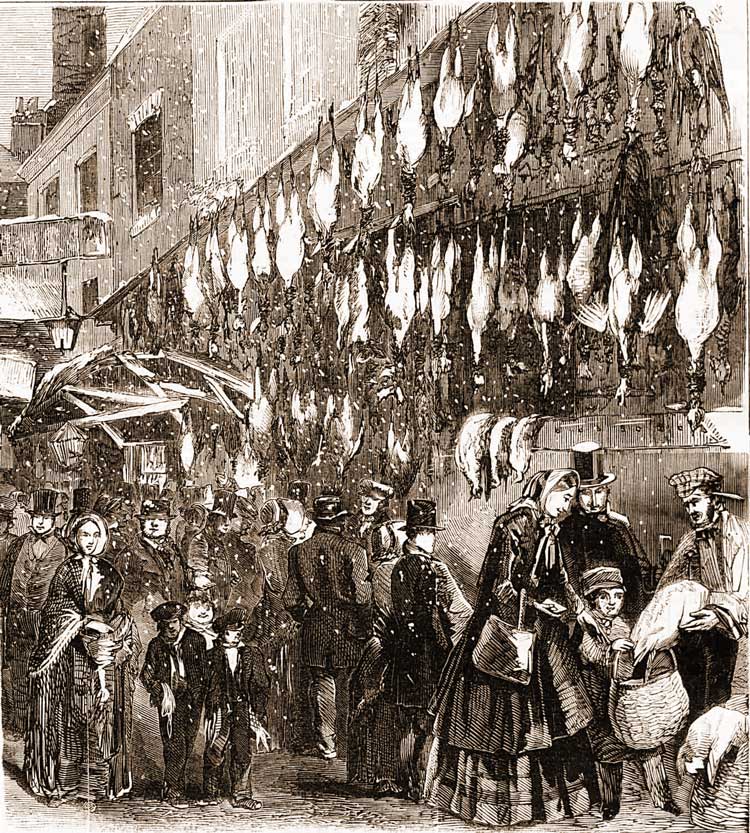
Leadenhall Market On Christmas Eve.
From The Lady's Own Paper, Saturday, 20th December, 1856.
Copyright, The British Library Board.
That Market was replaced by the current structure in 1881, and what a glorious place it is.
At Christmas, it looks particularly fine, resplendent as it is with festive decorations and a huge Christmas tree standing at its centre.
You can even see, if you look closely, the hooks outside the shops upon which the geese and turkeys would have once been hung.
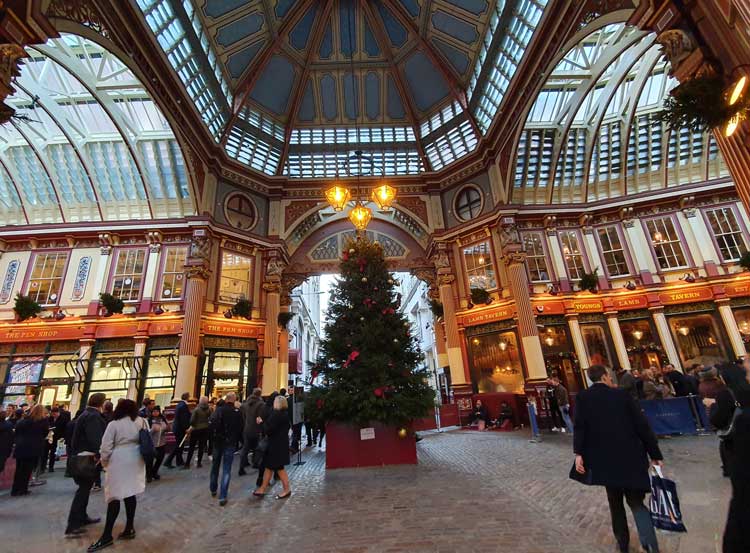
And so, we come to the end of our journey through the London locations that featured in A Christmas Carol, and we awake to a merrier Christmas morning, or whatever morning, afternoon or evening that you happen to be reading this!
Let's hope it can be truly said of us, as it was of Ebenezer Scrooge, that we know how to keep Christmas well, if any one alive possesses the knowledge.
And so, as Tiny Tim observed, God bless Us. Every One!